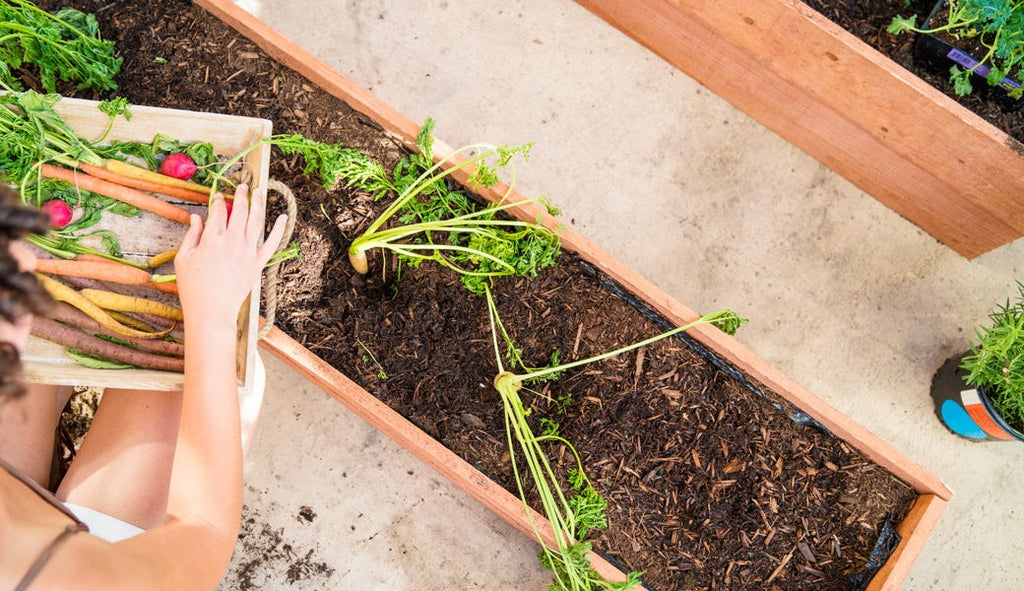Urban Gardening Basics
If you live in the urban jungle, the thought of gardening and growing your own food might seem like a fantasy. But urban gardening is a real thing and isn’t as hard as you might think! Whether you use a balcony, windowsill, rooftop, or use the neighborhood vacant lot as a community garden, there are many ways to enjoy the bounty that nature has to offer and bring some green to the cement cityscape.
The four main elements you’ll need to get started are a container, some potting soil, water, and a sunny spot. The first three are easy, the forth is the biggest challenge in an urban environment.
Container
For the container, you can buy a beautiful ceramic planter, a wooden or metal box, a grow bag, or opt for a cheap five-gallon bucket from your local big-box store. They honestly work equally well. Just make sure to add a hole or two to the bottom of whatever container you choose to provide drainage and to prevent root rot. It’s important to pick a container that provides enough depth for the plant’s roots. Salad greens and many herbs don’t need more than 5-6 inches of depth, while many summer veggies need at least a foot. A single tomato plant, for example, could use a five-gallon bucket by itself. There are fabulous self-watering planters that are outstanding options for urbanites as well as clever stackable or hanging pots.
Soil
For container gardening it is important to choose potting soil or a “soilless” potting mix, as opposed to topsoil or dirt from outside, since it retains moisture and resists compaction. Mix in a shovelful or two of compost or some organic fertilizer, and your green bambino will flourish. Consider using organic soil and fertilizer for food you will be eating.
Water
Plants, especially veggies, need a consistent supply of water. This is where a self-watering planter comes in very handy. If you have trouble remembering to water your seedlings, a good trick is to use a to-do app to remind you. You’ll want to keep the soil moist, but not too wet. If leaves start turning yellow, you’re watering too much. If the leaves are drooping, flaccid, and limp, the plant needs water.
Sun
Getting a full day of sun in an urban setting is nearly impossible unless you are able to use your rooftop as your gardening spot. If that’s the case, the sky’s the limit and you can grow pretty much any plant you want. If what you have available is a balcony or windowsill, though, and trees or other buildings block the sunlight, you’ll need to pick plants that can tolerate shade. In this case, herbs such as mint, basil, chives, oregano, or thyme are great options. If your planting spot gets between four to six hours of sun per day, you have what gardeners consider as partial sun, and salad greens like lettuce, arugula and chard are a good choice. Peppers, eggplants, and beans are also super simple to grow.
Plants
To seed or not to seed, that is the question. If you’re a beginner, skip the seeds and buy some seedlings instead. Seed packets usually have way too many seeds for most urban spaces, they take weeks to germinate, and can be tricky to grow. Remember to give your plants the room they need to grow. You’ll be amazed how huge a single tomato plant can get as compared to the seedling you buy. That five-gallon bucket will seem small by the time the tomato plant is full grown. If you crowd too many plants into a single container, they will fight for the same resources and not thrive. It’s better to give each plant their own container or space them well apart from each other.
The Reward
The best part about gardening, whether urban, suburban or rural, is enjoying the fruits of your labor. It is so satisfying to use your own fresh oregano or basil in your pasta sauce or on your pizza, eating a tomato directly from the vine, or making a salad exclusively from vegetables that you’ve grown. It’s fresher and more nutritious, reduces your carbon footprint, and is so much more flavorful than anything you could buy.










